Support Healthy Youth
Nearly 9 out of 10 adults who start smoking, started by age 18.
The commercial tobacco industry intentionally advertises to youth and young adults to use their products - and spends a lot of money doing it. They use deceptive tactics, like marketing candy/fruit-flavors and misleading language, to addict a new generation to their products. The industry’s deliberate marketing to youth and teens has fueled both the vaping/e-cigarette epidemic (hooking over 2.5 million U.S. kids to nicotine)1 and the environmental degradation caused by toxic tobacco waste.
Our Focus
Washington Breathes supports and advocates for comprehensive policies, practices, and programs that effectively influence youth and young adults against starting commercial tobacco use. We also support access to comprehensive nicotine cessation services for all youth and young adults who are using commercial tobacco products.
| Download our Fact Sheet: Policy Solutions to End Youth Commercial Tobacco Use |
"If it looks glamorous and it looks appealing, that’s going to be the first driver that will bring a horse to water. The flavors then get them to drink. And the nicotine keeps them coming back for more."
Brian King, Director, FDA Center for Tobacco Products
Data Snapshot
- On the 2023 Healthy Youth Survey, 18.2% of WA high school students (64,480 students) reported using some type of nicotine product during the last 12 months. Of those students, 45.3% (29,210 students), reported making a quit attempt.2
- 74% of WA 10th graders who currently use any type of vapor product use a flavored nicotine product. 43% of WA 10th graders who smoke cigarettes use menthol cigarettes.13
- 104,000 WA youth alive today will die prematurely from smoking.3
- Vapor products, specifically disposables (e.g. Puff Bar and Vuse), are the most common nicotine product used by youth.5
- 9,100 WA youth under 18 try cigarettes for the first time each year4.
- Youth and young adults under age 18 are far more likely to start tobacco use than adults, with 4 out of 5 smokers starting during adolescence.
- Nearly 55% of youth (ages 13-25 years old) who vape, also use cigarettes or another type of tobacco product (dual use).6
Healthy Youth Survey (HYS)
While cigarette use has declined among youth, e-cigarette use has increased in popularity:
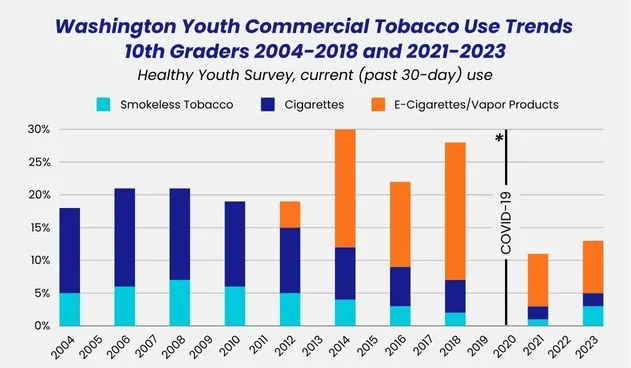
* HYS data is not directly comparable before and after COVID-19. In 2021, the survey shifted to primarily an all online format. There was a post-pandemic decrease in all youth substance use reporting; however the long-term impacts are unknown.
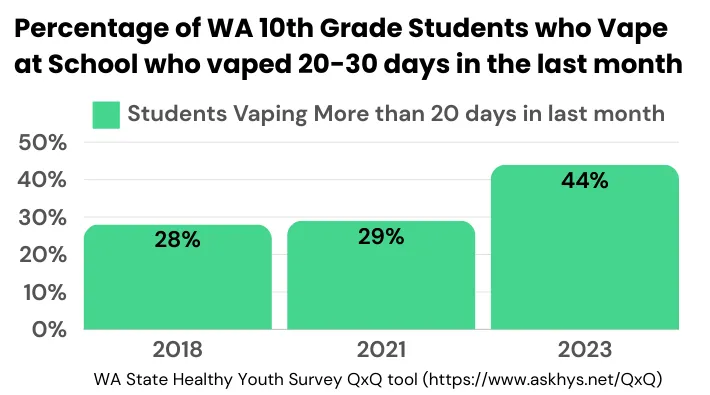
The number of WA youth vaping at school has decreased in recent years, however those who do vape are vaping more frequently. More frequent use indicates greater dependence on nicotine.
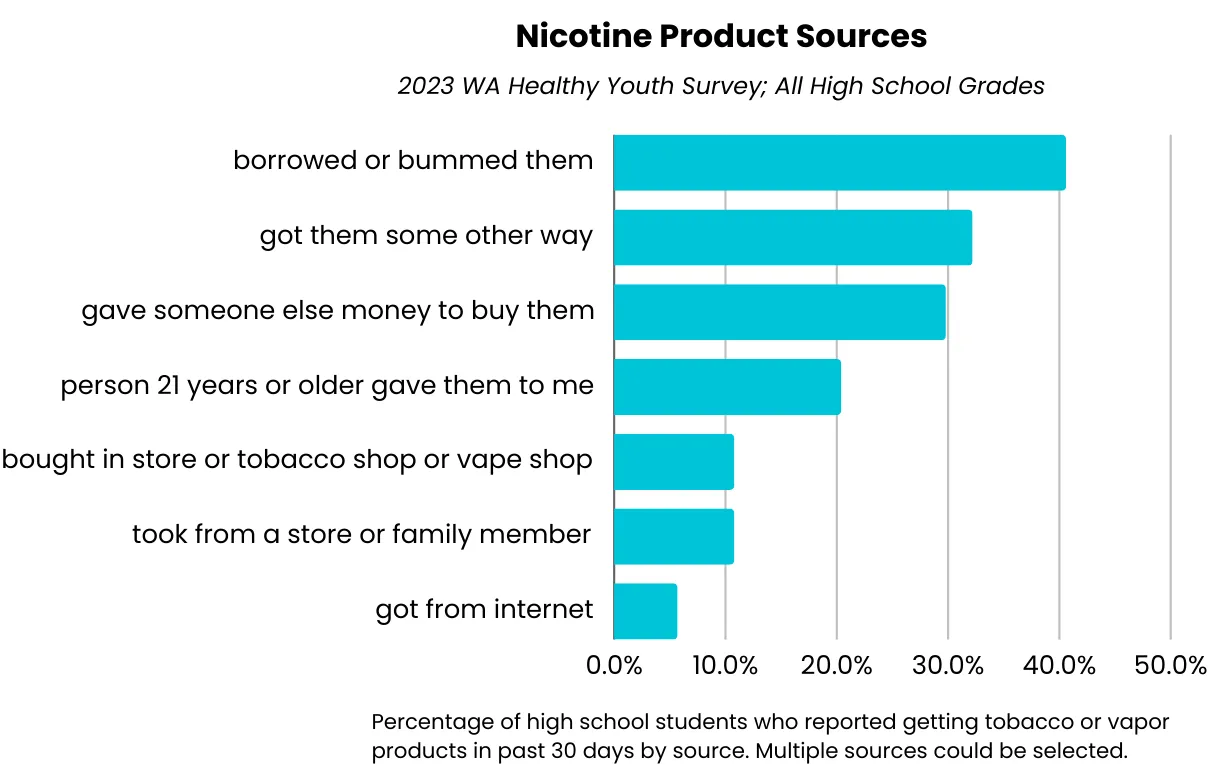
In 2023, WA students who used a nicotine product most frequently got it from a friend or from someone 21 years or older. Other sources contribute to the problem, including underage sales in retail stores.
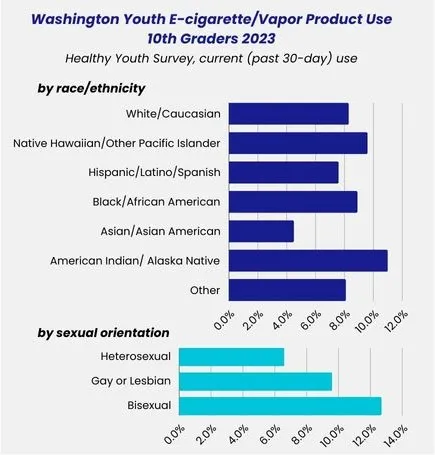
E-cigarette use is significantly higher among students of specific races/ethnicities or those who are lesbian, gay, or bisexual.
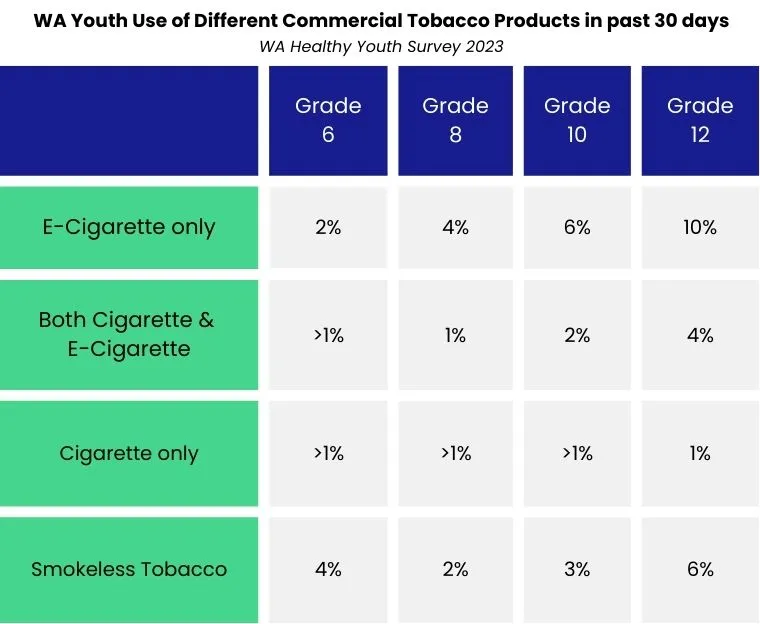
Youth who are using addictive nicotine products may use only one type of commercial tobacco product, or multiple products.
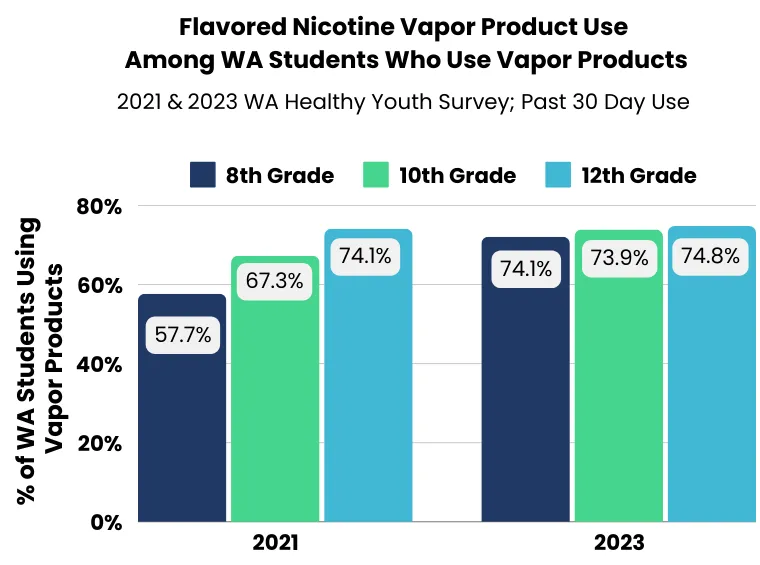
In the 2023 Healthy Youth Survey, 74% of WA 10th graders who currently use a vapor product reported using a flavored nicotine product. Nationally, 81% of teens (ages 12-17) who ever used a tobacco product, used a flavored product first.14
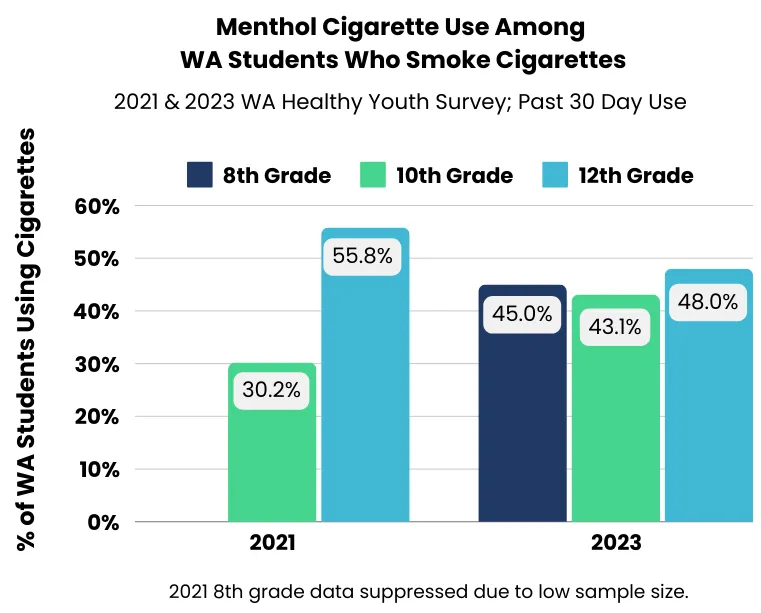
In the 2023 Healthy Youth Survey, 43% of WA 10th graders who smoke cigarettes used menthol cigarettes. Menthol is a cooling and numbing agent that makes it easier to start smoking or vaping, and harder to quit nicotine.
Washington's 2023 Healthy Youth Survey showed an increase in the number of students who reported using smokeless oral nicotine products (like the pouches Zyn and On!). This finding may also reflect that the 2023 survey question was updated to ask about use of nicotine pouches, lozenges, gum, or toothpicks - instead of only asking about chewing tobacco, snuff, or dip.
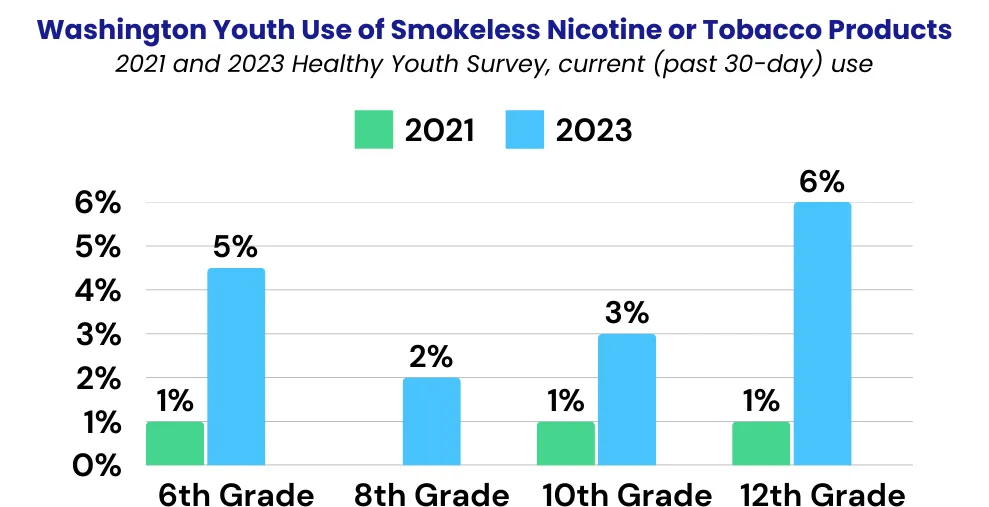
The graphs above are snapshots of survey data collected from the WA Healthy Youth Survey (HYS). Visit the Healthy Youth Survey* website to generate fact sheets on a variety of topics, divided by grade, state/county, year, and other factors and to view the Data Dashboard. Some of the charts shown above reflect HYS data analysis by the WA State Department of Health.
The 2024 National Youth Tobacco Survey has similar use findings and provides more details about the most commonly used types of e-cigarettes, which were: Elf Bar (36.1%), Breeze (19.9%), Mr. Fog (15.8%), Vuse (13.7%) and JUUL (12.6%).
Preventing Initiation
Almost all long-term commercial tobacco use starts in the teen and young adult years, which is why preventing initiation is so critical. The following are a few key ways to prevent youth from picking up e-cigarettes and other tobacco products:
- Comprehensive Policies and Laws: In 2020, Washington raised the legal sale age for tobacco to 21, aligning with federal law. Ending the sale of flavored products - which 81% of teens (ages 12-17) who use e-cigarettes, try first - would prevent youth initiation.7 Additionally, increasing taxes on vapor products and restricting sales near schools and playfields further limits youth access and use.
- Improving Funding for Prevention Strategies: More comprehensive and sustainable funding is needed to support a robust statewide tobacco prevention program. Increased funding would support effective, evidence-based school programs, community programs, and social and mass media campaigns for youth grades 4 through 12.
- Supporting Youth Education: The American Lung Association's 'The Vape Talk' is a valuable resource for parents to discuss vaping dangers with their children and to learn how to recognize the signs. There are also many dedicated and innovative community coalitions, local health departments, and organizations that provide teen risk reduction education in middle school and high school classrooms throughout the state. More support is needed for youth programming, like these.
- Fostering Environmental/Community Support: Setting a good role-model by not using commercial tobacco products is a critical piece to preventing initiation – particularly if you are a parent, educator, or healthcare professional. Strong family support and open communication between parents and adolescents/teens is also associated with reduced smoking risk.8
Targeted Marketing to Youth
The tobacco industry uses the same tactics to attract kids to e-cigarettes as they did with cigarettes, such as adding appealing flavors, designing concealable products, offering promotions and discounts, and advertising on social media, the Internet, and TV.9 The tobacco industry knows their customers are getting sick and dying from using their products, so they must target young people to sustain profits.
Stronger policies and enforcement measures are needed for manufacturers and retailers who violate marketing laws.
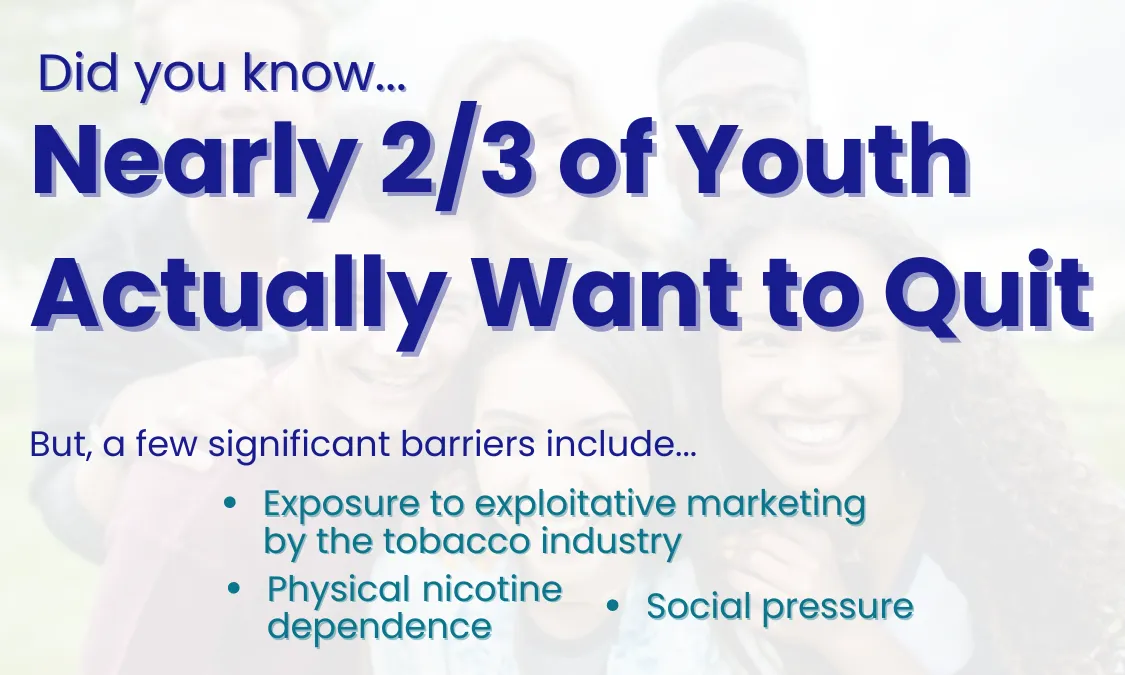
Washington Breathes is committed to supporting communities and countering the industry's targeted marketing of addictive products to youth and those most impacted by commercial tobacco use.
Supportive Interventions and Resources
Education/Prevention
- The Association of Washington School Principals (AWSP) met with students to determine what school leaders can start doing, stop doing, and keep doing to address the teen vaping epidemic: Students Weigh In: Vaping. What Can We Do?
- Cascadia Youth Mental Health provides training and consulting services to school professionals to help reform school discipline, enhance alternatives to suspension, and support youth mental health.
- Stanford Medicine’s Tobacco Prevention Toolkit
- American Heart Association: Youth Tobacco and Vaping Resources for Educators, Administrators, Parents, Students, Counselors, and Health Professionals
- Reinforcing Social Emotional Learning (SEL) techniques like high self-esteem, parental involvement, school involvement, athletics, and positive role models provide students with the tools needed to resist peer pressure.11
- The Truth Initiative has compiled a variety of ways that educators can better support students if they are caught vaping at school.
Cessation Programs
- N-O-T (Not On Tobacco): Interactive smoking and vaping cessation program for teens by the American Lung Association. N-O-T is led by trained facilitators who deliver the structured curriculum in schools or community-based settings. There is also an online, self-paced version.
- This is Quitting: Teens can text DITCHVAPE to 88709 to learn tips and tricks and receive encouragement for quitting. It’s easy, free, totally anonymous and available 24/7.
Find more quit programs on our Cessation/Quitting Support Services page.
Campaigns
- Fresh Empire Campaign (U.S. FDA): campaign designed to prevent and reduce cigarette smoking among youth ages 12-17 who identify with hip-hop culture – specifically African American, Hispanic, Asian American, and Pacific Islander youth.
- Empower Vape-Free Youth™ (CDC's Office on Smoking and Health): campaign to empower educators to speak with youth about the risks of e-cigarettes and nicotine addiction.
Comprehensive School Policies
Schools can play a critical role in combating the teen vaping epidemic by connecting students with supportive resources, supporting their quit attempts, and implementing comprehensive policies. However, Washington State schools often lack resources for nicotine prevention and cessation due to the insufficient state funding.
Washington Breathes promotes supportive school interventions - over punitive measures (like suspensions and detentions) - which do not recognize the student’s dependence on nicotine and need for supportive services.
Rethinking School Discipline Policies
In 2016, Washington State took steps towards improving school discipline policies by passing a law to eliminate zero tolerance approaches, providing proactive and restorative supports, and implementing strategies to help students meet behavioral expectations. The Washington Office of the Superintendent of Public Instruction (OSPI) partners with the WA School District Directors Association (WSDDA) to create model school policies and resources for schools, like:
- OSPI’s Student Discipline and Multi-Tiered System of Supports (MTSS) webpage explains student discipline laws and how to intergrate student support;
- OSPI’s overview fact sheet: Student Discipline Policies - Substance Use and Possession; and
- The WSDDA has model policies that school boards can adapt to create processes for addressing students who violate school policies.
- For example, the 3000 series has policy 3241/3241P – Student Discipline, with links to a Policy, a Procedure, and Form 1 and 2. 'Form 1' has the Discipline Matrix and 'Form 2' has the Continuum of Discipline Responses to each type of violation on the matrix.
There are a few other frameworks and initiatives that could be helpful to implement in Washington State schools:
- Change Lab Solutions has developed a framework for School Discipline Practices and provides guidance on why non-punitive approaches are so important for a students learning and development. Punitive approaches (like expulsion or referrals to law enforcement, for example) exacerbate racial disparities, adverse childhood experiences (ACE’s) and external stressors for students.
- The Vape Free Schools Initiative was created by the American Lung Association to assist schools in navigating the teen vaping epidemic by providing tools, resources, and guidance for students, parents, staff, and the community.
- The Public Health Law Center has developed a Commercial Tobacco Free K-12 School Model Policy with key findings, what needs to be included in the policy, developing the statements and exceptions, integrating cessation opportunities, enforcement, and dissemination of the policy.
Washington’s new school discipline approach began in the 2018-2019 school year and implementation is still ongoing. Resources and capacity to develop and implement the new policies and provide staff training varies greatly between districts and schools, leading to a range of implementation strategies statewide. Additional funding is needed to ensure every school and community is equipped to support school professionals in addressing youth substance use.
Support Students Mental Health
Identifying students who are using nicotine products is crucial for pinpointing those who need additional behavioral health support. The Healthy Youth Survey data shows that youth who vape, smoke, or use other nicotine products also have higher rates of depression, marijuana or alcohol use, and suicidal thoughts.
The Washington Office of Superintendent of Public Instruction (OSPI) has outlined ‘Red Flags for Support,’ with recommendations for schools to support students who vape or smoke by focusing on prevention, shifting from discipline to support, and screening for other substance use and mental health concerns. About Youth Now has a variety of resources, including a webinar on the "Red Flags," to assist counselors and healthcare professionals.
Alternatives to Suspension
- INDEPTH (Intervention for Nicotine Dependence: Education, Prevention, Tobacco and Health): Interactive program, created by the American Lung Association, to address teen vaping and nicotine use in a more supportive way. INDEPTH is an alternative to suspension or citation program and is taught by a trained adult in four, 50-minute sessions.
- Stanford Medicine’s Tobacco Prevention Toolkit, Healthy Futures, is an alternative to suspension curriculum that is offered in two formats, one taught by an educator, counselor, or advisor in a group format and one self-paced online course.
Nicotine Poisoning Risks for Young Children & Youth
The invention of vapor products created a new poisoning risk for young children, as nicotine is classified as a poison at certain levels. E-liquids - concentrated nicotine solutions - are often marketed with colors and images that appeal to young children. Swallowing, inhaling, and absorption of nicotine through the skin can cause serious symptoms and death in children. Most reported nicotine poisonings occur in children under 5 years old, though they affect all age groups and even pets.
While state (WA Vapor Products Act, RCW 70.345.130) and federal (Child Nicotine Poisoning Act) laws require child-resistant packaging for e-liquids, popular disposable e-cigarettes (e.g. Puff Bar and Elf Bar) and pod-based nicotine systems (e.g. JUUL and Sourin) are exempt, creating legal loopholes. 11,12 For example, in September 2025, the FDA urged nicotine product manufacturers to use child-resistant packing because of an increase in accidental exposures.
Did you know...
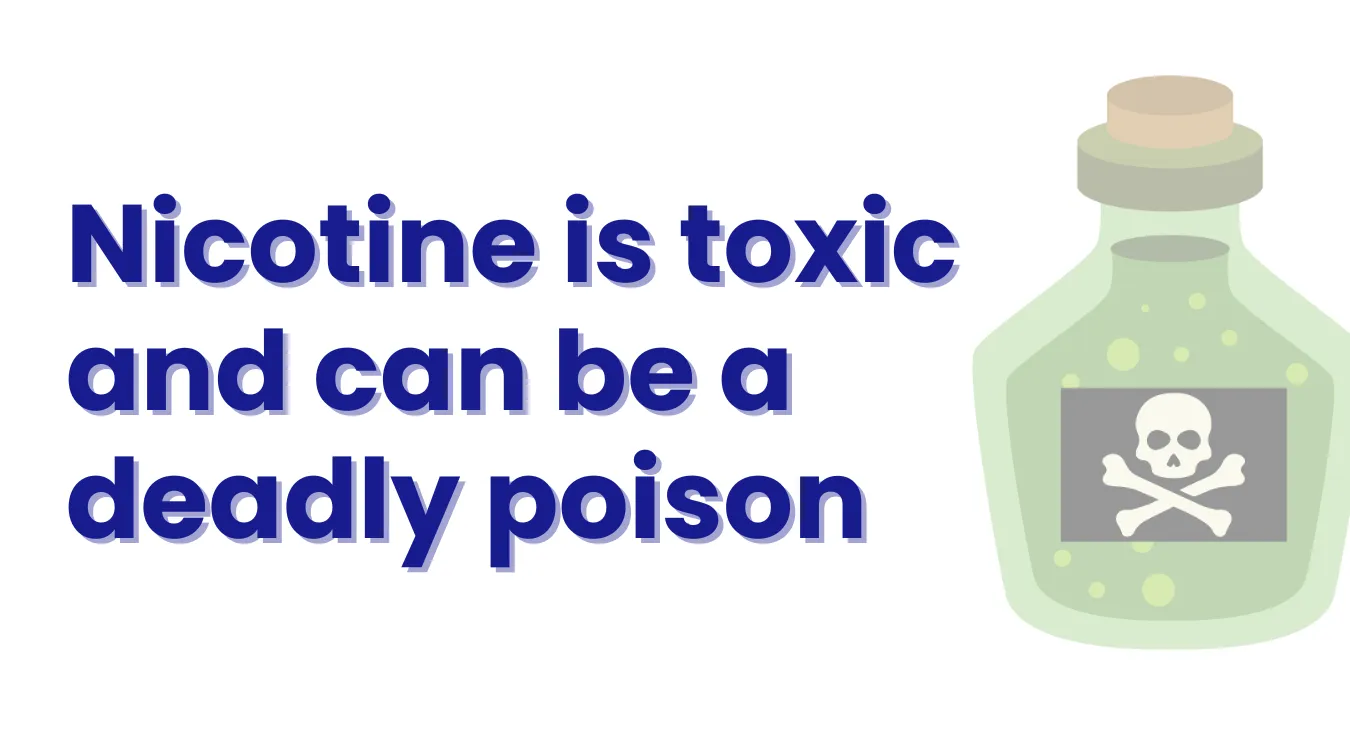
Properly storing all commercial tobacco products securely out of children's reach is critical for preventing youth access and poisonings. Additionally, stronger packaging requirements and eliminating flavored products would offer even better protection.
Sources
- Campaign for Tobacco Free Kids: https://www.tobaccofreekids.org/what-we-do/industry-watch/e-cigarettes
- Data from the 2023 WA Healthy Youth Survey analyzed by WA State Department of Health. High school enrollment figures from the 2023 OSPI WA State Report Card used to calculate total number of students.
- WA Department of Health: https://doh.wa.gov/data-statistical-reports/health-behaviors/tobacco
- Campaign for Tobacco Free Kids: https://www.tobaccofreekids.org/problem/toll-us/washington, accessed November 22, 2024
- WA Healthy Youth Survey: https://www.askhys.net/SurveyResults/FactSheets
- Journal of Adolescent Health: https://www.jahonline.org/article/S1054-139X(18)30186-1/fulltext
- Research studies on flavored product impacts cited in Truth Initiative fact sheet. June 2021. https://truthinitiative.org/research-resources/emerging-tobacco-products/flavored-tobacco-use-among-youth-and-young-adults
- International Journal of Environmental Research and Public Health: https://www.ncbi.nlm.nih.gov/pmc/articles/PMC8656923/
- American Lung Association: https://www.lung.org/research/sotc/by-the-numbers/10-bad-things-to-entice-kids
- The Centers for Disease Control and Prevention: https://www.cdc.gov/tobacco/data_statistics/fact_sheets/cessation/smoking-cessation-fast-facts/index.html
- National Association of Secondary School Principals: https://www.nassp.org/2023/04/12/empowering-teens-with-sel-skills-may-help-them-resist-drugs-and-vaping/
- The Centers for Disease Control and Prevention, “Notes from the Field: E-Cigarette–Associated Cases Reported to Poison Centers — United States, April 1, 2022–March 31, 2023” CDC, MMWR, June 2023. https://www.cdc.gov/mmwr/volumes/72/wr/mm7225a5.htm?s_cid=mm7225a5_w
- 2023 WA Healthy Youth Survey: https://www.askhys.net. Data analysis provided by WA State Department of Health.
- Research studies on flavored product impacts cited in the 2021 Truth Initiative fact sheet "Flavored tobacco use among youth and young adults"
- What Healthcare Providers Need to Know About Vaping and Youth (2-page PDF fact sheet from CDC)
- What Parents and Caregivers Need to know About Vaping and Youth (2-page PDF fact sheet from CDC)
- Policy Solutions to End Youth Commercial Tobacco Use (2-page PDF fact sheet from Washington Breathes)